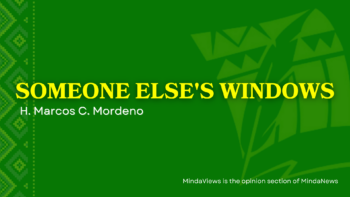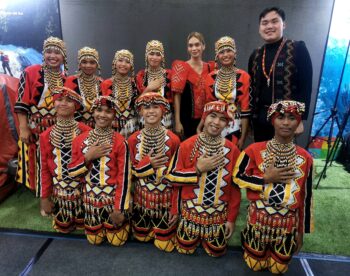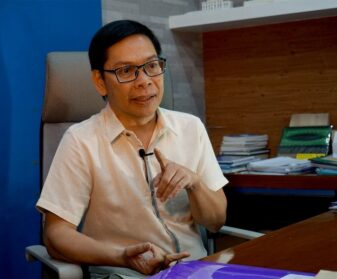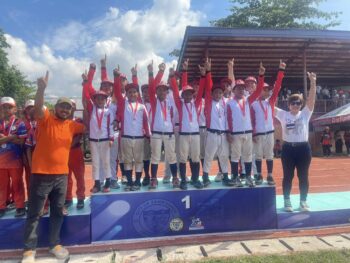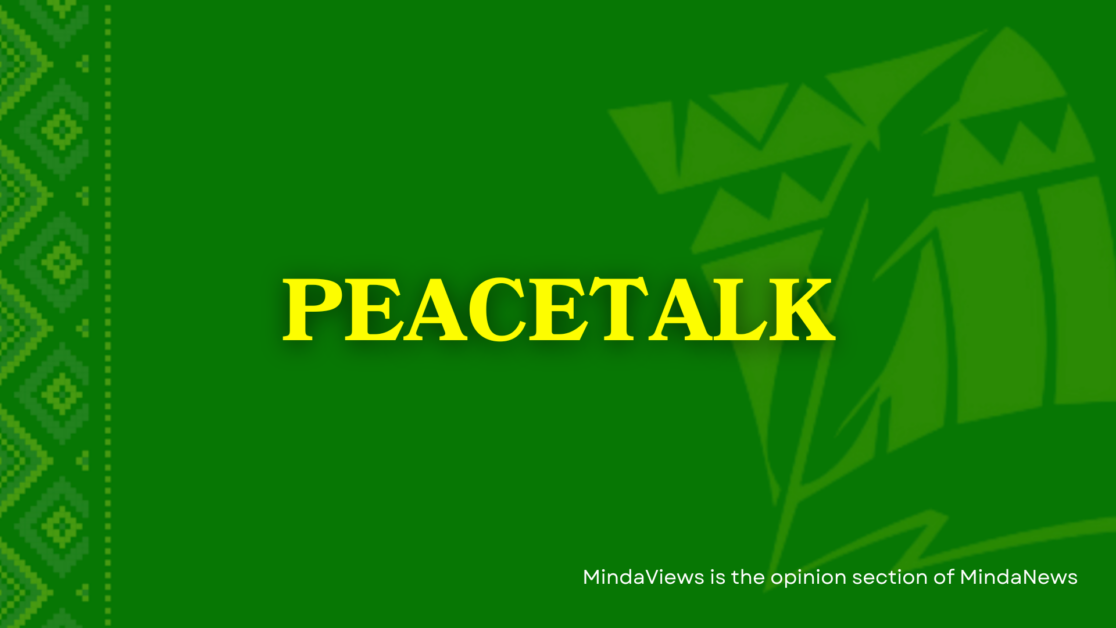
(Last of two parts)
Watersheds in Philippine and Bangsamoro History: War and Peace
NAGA CITY (MindaNews / 21 February) – In Philippine national history of the contemporary period of the past five or six decades, there are two clear key watershed events: first, the September 1972 declaration of martial law that established the Marcos dictatorship; and second, the February 1986 EDSA People Power Revolution which ousted Marcos and restored pre-martial law formal democracy.
THE MNLF’s TIME
In Bangsamoro history, the initial watershed event is the 18 March 1968 Jabidah Massacre believed to be perpetrated by Philippine military officials against a number of young Filipino Muslim/ Tausug recruits who mutinied upon learning that their secret military training in Corregidor Island was to deploy them in an Operation Jabidah to seize control of Sabah from Malaysia. This pre-martial law event is considered the triggering event for the contemporary Moro armed struggle in the Philippines. It was the foundational raison d’etre or casus belli of the Moro National Liberation Front (MNLF) as conceptualized by its Founding Chairman Misuari, even as he actually founded the MNLF in 1969 while its first batch called the “Top 90” were undergoing military training in Malaysia and even as the name “MNLF” emerged only in 1970. It took the martial law declaration in September 1972 for Moro armed resistance and the MNLF leading it to break out in the open.
The MNLF track of war and peace on the Moro front may be said to have dominated that scene from the 1968 Jabidah Massacre and the 1972 martial law declaration up to the 1996 GRP-MNLF Final Peace Agreement (FPA). Within that 24-28 years period from 1968/1972 to 1996, the main watershed on the Moro front was the 1976 Tripoli Agreement. Before that, from 1972 to 1976 (this is where the 1974 Jolo Siege is situated historically), it was a mainly war phase of the MNLF track. After that, from 1977 to 1996, it was a mainly peace phase of the MNLF track.
It will be noted that during the latter phase, there occurred the key watershed event of the February 1986 EDSA Revolution that ended the Marcos dictatorship and restored formal democracy. Restored democracy, despite all its admitted elitist limitations, was definitely a more favorable factor for various peace processes than was/is dictatorial or authoritarian rule. It will be recalled that the immediate post-EDSA President Corazon Aquino no less went to meet with Misuari in his Jolo stronghold in September 1986. Within 10 years – though it was not as simple or as easy as that – the 1996 FPA with the MNLF was signed under Aquino’s successor President Ramos.
It must also be recalled that, soon after the MNLF track main watershed event of the 1976 Tripoli Agreement, particularly in December 1977, the not yet named MILF faction under MNLF Vice-Chairman Salamat Hashim split from the MNLF on the main policy issue of the latter’s new autonomy path contrary to its original independence path. By March 1984, the split and faction name was formalized by Hashim’s issuance of the “Declaration of the Moro Islamic Liberation Front (MILF),” which highlighted its decidedly Islamic orientation to further distinguish itself from the secular nationalist MNLF, aside from their then different paths of Moro self-determination.
Still on the MNLF track, in 2001, several years after the 1996 FPA and for purported purposes of implementing it, Republic Act No. 9054, the new Organic Act for the Autonomous Region in Muslim Mindanao (ARMM) was passed under President Arroyo. But Misuari and his main faction in the MNLF rejected this based on their view that it was not faithful to the peace agreement. Another MNLF faction, the “Executive Council of 15,” was placed at the helm of the ARMM. As a result, the Philippine government’s relations with the MNLF main Misuari faction have not been smooth and have even seen several outbreaks of significant armed hostilities initiated by the MNLF Misuari, often in protest against what they consider as adverse developments in the Mindanao peace process both with the MNLF and the MILF.
THE MILF’s TIME
In the meantime, the MILF track has become dominant in the Moro front of war and peace. This track can be reckoned from its 1977 split with the MILF up to the 2014 Comprehensive Agreement of the Bangsamoro (CAB) between the GRP and the MILF on a new autonomous political entity (NPE) to replace the ARMM. This was preceded by the breakthrough 2012 Framework Agreement on the Bangsamoro (FAB). Both this and the culminating CAB came under President Benigno Aquino III. The GRP-MILF peace negotiations actually started as early as January 1997, still under President Ramos, with the MILF single talking point “To solve the Bangsamoro problem,” just several months after the 1996 FPA with the MNLF, implying that the latter peace agreement had not fully or adequately solved it. Like the MNLF track, the MILF track had first a mainly war phase from 1977 to 1996, and then a mainly peace phase from 1997 to 2014.
Also, in 2018, several years after the 2014 CAB and to implement it, R.A. No. 11054, the Organic Law for the Bangsamoro Autonomous Region in Muslim Mindanao (BARMM) was passed under President Duterte. The MILF took the helm of the BARMM’s Bangsamoro Transition Authority (BTA) in 2019. It is clear that like the MNLF, the MILF has – at least for now – moved down from independence to enhanced autonomy as the path for Moro self-determination. The inclusion of the MNLF in the MILF-led BTA has become the current expression of MNLF-MILF unity somewhat ironically brought together this way under President Marcos Jr. MNLF-MILF unity is considered crucial for the whole Bangsamoro cause and the Mindanao peace process. Getting their act together should not just be a matter of power-sharing but something more substantive in terms of the Bangsamoro agenda. They would do better to reconcile and harmonize the 1996 FPA and the 2014 CAB for peace and unity rather than go separately about their respective peace agreements with the government.
The jury is still out, as they say, on this current implementation stage of the Mindanao peace process with both the MNLF and MILF. But for now, we might sum up the above-given sweep of Philippine and Bangsamoro history of the past five or six decades with these words from the title of a 2017 article by Agnes Aliman: “Lessons from ’70s Jolo: War and martial law won’t solve the problem.” That may well refer to the Bangsamoro problem. Martial law is definitely a government imposition as in a dictatorship or authoritarian rule. War is by its nature waged by at least two conflicting parties. If not war and martial law, then peace (processes) and democracy (with its fundamental freedoms and civil liberties) should solve it.
Interestingly, a recent study entitled “The Age of Conflict” done by the Economist Intelligence Unit (EIU) shows that democratic standards across the world fell in 2023 amid the spread of wars, authoritarian crackdowns and declining levels of trust in mainstream political parties. The study said that “Today’s wars are concentrated in countries where democracy is absent or in trouble.” This would seem to indicate that the level of democracy has some bearing on the likelihood of wars. We might conversely surmise that democracy also has some bearing on the viability of peace processes. And the Philippine martial law experience appears to largely validate this.
Why Never Forget the Jolo Siege of 1974?
Never forget the Jolo Siege because it is a most poignant symbol of at least two important historical truths. First of all, it is a symbol of Moro armed resistance to martial law. In fact, it was the strongest resistance of any sort to martial law during its early years of 1972-76. That Moro armed resistance led by the MNLF deserves due historical recognition for this.
Secondly, the Jolo Siege is a symbol of the horrors of war, aside from the horrors of martial law. Again, to be clear, while martial law is a government imposition, war is a two-sided matter in terms of its horrors, caused by both sides, in this case of internal armed conflict, government and rebel. This war between brothers, Filipino and Moro, as we said, the fiercest and bloodiest fighting in the Philippines since World War II, can be even more horrific than that between Filipinos and foreign invaders, whether Spaniards, Americans and Japanese. The afore-mentioned books by Criselda Yabes and Agnes Aliman, the written testimonies of survivors like Said Sadain Jr., Dr. Abas Candao and Noor Saada, and the oral testimonies of the afore-mentioned three survivors in the 50th anniversary panel discussion speak well about those horrors.
Never forget those, precisely so that they may never again happen. George Santayana famously said, “Those who cannot remember the past are condemned to repeat it.” But so-called Sieges like that of Jolo have recurred since then. Witness Ipil of 1995, Cabatangan of 2001 (MNLF), Zamboanga of 2013 (MNLF), and Marawi of 2017. It is disturbing that the MNLF for one is implicated in three out of these five Sieges, with certain derogatory actuations like hostage-taking and the use of human shields to extricate themselves from encirclement, and even house burning to smoke-cover their locations or retreat. The recent court dismissal of Misuari’s Zamboanga Siege cases for such war crimes seems like a privileging of peace in favor of justice, even as these two aspirations need not be mutually exclusive. The problem is that the war crimes cases under our domestic law R.A. No. 9851 (covering the same crimes as that of the 1998 Rome Statute of the International Criminal Court) are filed only against alleged rebel perpetrators, and not against soldier or police perpetrators. There thus appears to be more impunity for the latter.
Questions of War Crimes and Genocide
This brings us to certain questions of war crimes and genocide pertinent to the Jolo Siege of 1974. To be sure, there are contending versions about particular issues involving one or both sides, aside from the main issue of the burning of Jolo, among them the following:
– the use of napalm bombs by the PAF on the town center presumably against MNLF targets
– the PAF strafing of the town center presumably against MNLF targets
– the MNLF use of landmines as defensive emplacements in the town center after infiltrating it or withdrawing there from the Notre Dame building area
– the MNLF decision to withdraw to and fight in the town center amidst the civilian population there, instead of retreating outside to avoid further confrontation with the AFP and civilian casualties
– internal displacement, both forced and voluntary, including assisted evacuation by both sides
– the positive and/or negative roles of certain commanders on both sides, with special attention on AFP Commodore then Rear Admiral Romulo Espaldon
I agree with online panelist Agnes Aliman’s remark that the weight of the evidence points to the major responsibility of the AFP for the burning of Jolo, given its superior explosive and incendiary weaponry (not necessarily napalm bombs, which warrants more definitive scrutiny), but I would not rule out the MNLF resort to house burning to smoke-cover their locations in and eventual retreat from the town center (a pattern repeated in the Zamboanga Siege).
The PAF strafing of the town center presumably against MNLF targets and the MNLF use of landmines as defensive emplacements in the town center were both anecdotally confirmed by survivor “Cheng” Rasul as his “near-death experiences” shared at the panel discussion.
The MNLF said that it was forced to move out of Jolo town to guide civilians, especially the Catholic parish priest and four nuns, into safer places so that they would escape the resurgence of massacres perpetrated by the AFP. The AFP in turn accused the MNLF of using those civilians as human shields to cover their retreat.
The MNLF had accused the AFP that on February 7 afternoon, they assembled the civilians in Busbus and massacred them, mostly men about 300 of them, with around 500 more civilians taken as hostages at the Brigade. Small children and women, both young and old, were molested and raped.
If true, such atrocities and others like indiscriminate bombing, shelling and strafing by the AFP, and the use of human shields and any deliberate close-quarters house burning by the MNLF, would easily enough, as the evidence may warrant, count as specific acts of war crimes or serious violations of the rules of war and international humanitarian law (IHL).
Whether whatever AFP atrocities during the Jolo Siege and other related events in Mindanao during the early 1970s constituted genocide against the Moro people as was once charged by the MNLF is more difficult to determine. In the recent International Court of Justice (ICJ) case of South Africa vs. Israel charging the latter with genocide against the Palestinian people in the still ongoing Gaza War, the crucial element is the “specific intent” to destroy, in whole or in part, a national, ethnic, racial or religious group. Without that mental element of “specific intent” established, the proven atrocities might amount to various specific war crimes only but not the more serious and wider ethnic cleansing-type pattern of acts that would constitute genocide.
Again, the jury is still out on that, pending more definitive, credible and authoritative findings. On one hand, the OIC, in the official report of its Quadripartite Commission, after thorough fact-finding on the ongoing war on invitation of President Marcos in 1974, indicated no genocide. On the other hand, six years later, in 1980, the unofficial non-(inter)governmental Permanent People’s Tribunal (PPT) Session on the Philippines in Antwerp, Belgium – where the Filipino people were represented by the National Democratic Front of the Philippines (NDFP) and the Bangsamoro people were represented by the MNLF, and no GRP representation – issued a Verdict which found, among others, that the Marcos regime committed crimes of genocide against the Bangsamoro people.
The heavy bombardment of populated areas and civilian infrastructure seen in the Jolo, Zamboanga and Marawi Sieges reflect certain new developments, trends and issues in warfare: war on and in cities and other populated areas, increasingly urban rather than rural warfare. Witness the most recent Ukraine and Gaza Wars, though these both have additional high-tech (especially drone and AI use) features. All-told, law, particularly IHL, has to catch-up with warfare.
How Should We Recall the Jolo Siege Today? (or What is to be done?)
These actions questions are perhaps best approached and addressed with the useful framework of Transitional Justice for dealing with the past of dictatorships or of decades-long major armed conflicts. This framework revolves around four rights: the right to know, the right to justice, the right to reparation, and the guarantee of non-recurrence. Fortunately, this framework was adopted in the Mindanao peace process, particularly in the 2014 CAB with the MILF and in the 2018 Bangsamoro Organic Law. The latter specifically provides for Transitional Justice in Section 1 of Article IX on Basic Rights as follows: “The Bangsamoro Parliament, taking into account the report of the Transitional Justice and Reconciliation Commission, shall enact a transitional justice mechanism to address the legitimate grievances of the Bangsamoro people and the indigenous peoples, such as historical injustices, human rights violations, and marginalization through unjust dispossession of territorial and proprietary rights and customary land tenure.”
In the 2016 Report of the Transitional Justice and Reconciliation Commission (TJRC), the “burning of Jolo” in February 1974 is in fact specifically mentioned in its discussion of patterns of international human rights law (IHRL) and international humanitarian law (IHL) violations in the context of the armed conflict in the Bangsamoro. It deals with such violations by State actors, characterized by the disproportionate use of force and commission of mass atrocity crimes; but it also deals with violations by non-state armed groups.
Unfortunately, the said transitional justice mechanism has not yet been enacted by the Bangsamoro Parliament. Without prejudice to that, there may be other mechanisms to address the above-said four rights of transitional justice. The right to know the truth of what really happened can be addressed by continuing historical work by the academe, by government historical commissions and by civil society historical initiatives especially at the local and regional levels, short of any new truth (and reconciliation) commission on martial law and on the Moro armed conflict.
For one, as regards the Jolo Siege of 1974, there is a need for its deeper understanding on at least two levels: the event itself, and its part in history. At the level of the event itself, as shown by the foregoing discussion as well as by last February 12’s Forum panel discussion, there are still “loose threads of history that dangle and hang untied.” There is a need to clear the fog of war and propaganda (of both sides, actually). Online panelist Prof. Elgin Salomon has written and spoken on the martial law propaganda of the Marcos dictatorship regarding the Jolo Siege. This featured an early case of false “Red-tagging” by the government and the military of the MNLF as “Maoists” and “Communists.” And panelist survivor Dorothy Gokioco showed living proof of the long-lasting effect of such propaganda.
At the level of the Jolo Siege’s part in history, we might again speak of two sub-levels. First, its part in the anti-martial law dictatorship fight. And second, its part in the Bangsamoro Revolution for self-determination and independence led by the MNLF. Just like the CPP-NPA’s fight against the “U.S.-Marcos dictatorship” was also part of its still ongoing national-democratic revolution to overthrow the ruling “semi-colonial and semi-feudal” system. We should be aware of both the martial law and the revolutionary contexts when it comes to the historical roles of the MNLF and the CPP-NPA.
As for the rights to justice and reparation and the guarantee of non-recurrence, the criminal justice system prosecution of particular old cases of war crimes and genocide such as in the Jolo Siege of 1974 may no longer be feasible in both legal and practical terms. Without prejudice to criminal prosecution where it may still be feasible, a more comprehensive kind of redress that addresses a whole historical period such as martial law and the Moro armed conflict (these overlapped from September 1972 to February 1986, but might also include the precursor March 1968 Jabidah Massacre and other pre-martial law massacres) could conceivably result in doable measures of justice, reparation and non-recurrence.
Transitional justice advocate Rufa Cagoco-Guiam, “Kris-Crossing Mindanao” columnist of the Philippine Daily Inquirer, says “This process can start with an acknowledgement [and apologies, I might add] from perpetrators or their present representatives on the commission of such atrocities.” That kind of start or restart is what would lead to the best kind of closure for the victims and survivors. Of course, this would also be without prejudice to sooner doable measures of compensation, such as that already provided under R.A. No. 10368 for reparations and recognition of victims of human rights violations during the Marcos regime, and under R.A. No. 11696 for compensation to Marawi Siege victims.
Given already several existing initiatives for transitional justice, including by the Commission on Human Rights (CHR), as well as propositions for a martial law truth (and reconciliation) commission, there is a need to map and most importantly to harmonize these as much as possible with a view to ideally maximize the various efforts by some complementation and coordination and thus avoid their duplication or worse, working at cross-purposes. This might be something for Bantayog, for one, to consider, explore and initiate – perhaps like it did with its like-minded co-sponsors for “The Siege of Jolo 1974: A Forum and Webinar with Survivors and Victims.”
Bantayog ng mga Bayaning Pilipino at/o Bangsamoro?
Finally, this memorializing question of concern to Bantayog for martial law martyrs and heroes as well as to the HRVVMC for human rights violations victims. Both Bantayog and HRVVMC admittedly have a dearth of Moro representatives in their current rolls of honor and recognition. This despite the Moro armed resistance being the strongest resistance of any sort to martial law during its early years, and that the most horrific human rights violations as well as war crimes were committed during that armed conflict in Muslim Mindanao. Of course taking available and prospective resources into consideration, among others, Bantayog and other stakeholders should mull the best possible options: purposively having more Moro martyrs and heroes in Bantayog ng mga Bayani, OR having an autonomous Bangsamoro Bantayog and coordinating with each other, OR both. In any case, whatever option, it would be best to do historical justice to both the Philippine and the Bangsamoro perspectives.
In this way, we can make the best sense of what happened, we can find meaning in the losses and trauma of the victims and survivors as well as in the courage and sacrifices of the martyrs and heroes, we can heal better, we can learn the lessons of history so as not to repeat it, and we can move forward for real and lasting democracy, peace and progress in Jolo, in the Bangsamoro and in the Philippines. Insha’allah.
(SOLIMAN M. SANTOS JR. is a retired RTC Judge of Naga City, Camarines Sur, serving in the judiciary there from 2010 to 2022. He has an A.B. in History cum laude from U.P. in 1975, a Bachelor of Laws from the University of Nueva Caceres (UNC) in Naga City in 1982, and a Master of Laws from the University of Melbourne in 2000. He is a long-time human rights and international humanitarian lawyer; legislative consultant and legal scholar; peace advocate, researcher and writer; and author of a number of books, including on the Moro and Communist fronts of war and peace. Among his authored books are The Moro Islamic Challenge: Constitutional Rethinking for the Mindanao Peace Process published by UP Press in 2001; Judicial Activist: The Work of a Judge in the RTC of Naga City published by Central Books in 2023; and his latest, Tigaon 1969: Untold Stories of the CPP-NPA, KM and SDK published by Ateneo Press in 2023.)

